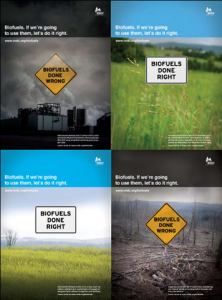 The notice of proposed rulemaking on the Renewable Fuels Standard may be imminent.
The notice of proposed rulemaking on the Renewable Fuels Standard may be imminent.
News out of Washington last week was that the Office of Management and Budget has completed the review of the Environmental Protection Agency’s rule, specifically as it relates to indirect land use and greenhouse gas emissions of biofuels compared to gasoline.
 Renewable Fuels Association president Bob Dinneen says they expect to see the rule from EPA proposed soon. “The agency has been working hard to get the rulemaking done and is under increasing pressure to do so,” said Dinneen. “Some believe that the ethanol industry is reluctant to see this rule hit the streets, that we don’t want to see an open and honest debate about the greenhouse gas issues that are teed up in this rulemaking. Just the opposite is true. We want this rule out there, we want to see all the numbers available for the public.”
Renewable Fuels Association president Bob Dinneen says they expect to see the rule from EPA proposed soon. “The agency has been working hard to get the rulemaking done and is under increasing pressure to do so,” said Dinneen. “Some believe that the ethanol industry is reluctant to see this rule hit the streets, that we don’t want to see an open and honest debate about the greenhouse gas issues that are teed up in this rulemaking. Just the opposite is true. We want this rule out there, we want to see all the numbers available for the public.”
Dinneen says they believe a complete evaluation of the science “will demonstrate that ethanol’s impact on indirect land use change is minimal and the significant direct benefits of adding ethanol to gasoline is extraordinary and is a policy that needs to be expanded.”
There are concerns that the recent decision by the California Air Resources Board regarding indirect land use impacts of ethanol will have a bearing on EPA’s rulemaking, but Dinneen believes the agency is looking at a different model for assessing greenhouse gas impacts that will be more favorable for ethanol and other biofuels.


 According to the
According to the  Valero officials say they are offering farmers with forward contracts a bonus of 40 percent of the difference between the cash price for corn and the futures price on the contract. Valero spokesman Bill Day says most suppliers have accepted the deal. We said when we bought those plants we were looking forward to having a good working relationship with local suppliers. This is what we meant by that. It’s good for us, it locks in supply. It’s good for them as well,” said Day. Valero agreed to purchase seven ethanol facilities and have closed the deal on six of them. Four of the plants are in currently operating.
Valero officials say they are offering farmers with forward contracts a bonus of 40 percent of the difference between the cash price for corn and the futures price on the contract. Valero spokesman Bill Day says most suppliers have accepted the deal. We said when we bought those plants we were looking forward to having a good working relationship with local suppliers. This is what we meant by that. It’s good for us, it locks in supply. It’s good for them as well,” said Day. Valero agreed to purchase seven ethanol facilities and have closed the deal on six of them. Four of the plants are in currently operating.  For some time, we’ve been telling you about Destiny, Florida, a 41,000-acre community founded in 2005 in South Central Florida, designed to one day be America’s first eco-sustainable city with 16,000 green tech jobs, including building solar panels (see our
For some time, we’ve been telling you about Destiny, Florida, a 41,000-acre community founded in 2005 in South Central Florida, designed to one day be America’s first eco-sustainable city with 16,000 green tech jobs, including building solar panels (see our  Minnesota has upped its biodiesel requirement today from 2 percent to 5 percent, making the state the first in the nation to move to that high of blend of the green fuel.
Minnesota has upped its biodiesel requirement today from 2 percent to 5 percent, making the state the first in the nation to move to that high of blend of the green fuel. “Following California’s recent decision to use flawed models to estimate ethanol’s environmental impact, I am concerned that the EPA could soon apply similar standards that will handicap renewable fuel relative to regular gasoline,” said Thune. “Congress has asked EPA to apply greenhouse gas emission standards that reflect ethanol’s proven environmental benefits. However, with the EPA’s current decision that is pending at the White House, I am concerned that EPA’s action could have a detrimental impact on our renewable fuel industry and efforts to reduce our dependence on foreign oil.”
“Following California’s recent decision to use flawed models to estimate ethanol’s environmental impact, I am concerned that the EPA could soon apply similar standards that will handicap renewable fuel relative to regular gasoline,” said Thune. “Congress has asked EPA to apply greenhouse gas emission standards that reflect ethanol’s proven environmental benefits. However, with the EPA’s current decision that is pending at the White House, I am concerned that EPA’s action could have a detrimental impact on our renewable fuel industry and efforts to reduce our dependence on foreign oil.” A new campaign funded by the
A new campaign funded by the  I went back in time this week (if you can call five years ago back in time) and read
I went back in time this week (if you can call five years ago back in time) and read  has been writing and teaching in sustainability and energy for many years to agree or disagree with him, he is one to watch.
has been writing and teaching in sustainability and energy for many years to agree or disagree with him, he is one to watch. The
The  The
The